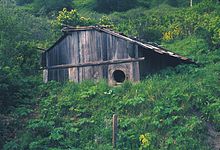Prior to European contact, indigenous Californians had 500 distinct sub-tribes or groups, each consisting of 50 to 500 individual members.[18]: 112 The size of California tribes today are small compared to tribes in other regions of the United States. Prior to contact with Europeans, the California region contained the highest Native American population density north of what is now Mexico.[18]: 112 Because of the temperate climate and easy access to food sources, approximately one-third of all Native Americans in the United States were living in the area of California.[22]
Early Native Californians were hunter-gatherers, with seed collection becoming widespread around 9,000 BCE.[18]: 112 Two early southern California cultural traditions include the La Jolla complex and the Pauma Complex, both dating from c. 6050–1000 BCE. From 3000 to 2000 BCE, regional diversity developed, with the peoples making fine-tuned adaptations to local environments. Traits recognizable to historic tribes were developed by approximately 500 BCE.[18]: 113

The indigenous people practiced various forms of sophisticated forest gardening in the forests, grasslands, mixed woodlands, and wetlands to ensure availability of food and medicine plants. They controlled fire on a regional scale to create a low-intensity fire ecology; this prevented larger, catastrophic fires and sustained a low-density "wild" agriculture in loose rotation.[23][4][3][24] By burning underbrush and grass, the natives revitalized patches of land and provided fresh shoots to attract food animals. A form of fire-stick farming was used to clear areas of old growth to encourage new in a repeated cycle; a permaculture.[3]
Wiki



No comments:
Post a Comment